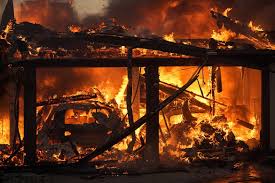Firefighters on both coasts of the U.S. are battling intense wildfires, highlighting the growing threat of fire even late into the year. On the East Coast, a deadly blaze in New York and New Jersey claimed the life of an 18-year-old parks employee. In California, the Mountain Fire has already destroyed over 130 structures and forced thousands to evacuate, as gusty Santa Ana winds drive its rapid spread.
In California’s Ventura County, the Mountain Fire has consumed approximately 32 square miles. While containment improved slightly to 26%, officials warn of ongoing risks to communities and critical infrastructure. The cause of this devastating blaze remains under investigation, but dry conditions and fierce winds have complicated firefighting efforts.
Meanwhile, in New York’s Sterling Forest near Greenwood Lake, crews are mourning the loss of Dariel Vasquez, who was struck by a falling tree while working on the fire line. This tragedy underscores the dangers faced by wildland firefighters as they confront unpredictable and perilous conditions.
The Jennings Creek Wildfire in New Jersey, which grew to nearly five square miles, has prompted evacuations and threatened multiple structures. The fire’s intensity has also led to air quality warnings across the region, with officials urging vulnerable populations to limit outdoor activities.
On both coasts, health advisories have been issued due to heavy smoke. In parts of New York and New Jersey, authorities have warned of unhealthy air quality, urging residents with respiratory conditions to stay indoors.
California’s fire season, which now seems to stretch year-round, has strained resources as crews work tirelessly to protect homes and lives. Fire officials have described the terrain as steep and rugged, complicating efforts to establish containment lines.
In the East, local and state fire agencies have rallied to combat the Jennings Creek blaze. Crews have been working under challenging conditions, including erratic wind patterns that risk spreading the fire further.
This dual-coast wildfire crisis has reignited discussions on climate change and its role in intensifying fire seasons. Prolonged droughts and higher temperatures have created a perfect storm for wildfires, with officials emphasizing the need for long-term mitigation strategies.
Fire crews are relying on air support and bulldozers to tackle inaccessible areas, but the scale of the devastation has underscored the difficulty of firefighting in densely populated regions and wilderness alike.
While some progress has been made, with partial containment of certain fires, the fight is far from over. Weather conditions over the coming days will be critical in determining the success of these efforts.
Emergency shelters have been established for evacuees in California, while similar measures are being taken in New Jersey to ensure displaced residents receive necessary aid.
Local communities have shown resilience, with volunteers assisting both firefighters and displaced families. However, the emotional toll of these wildfires is evident as residents assess the damage to their homes and livelihoods.
Officials continue to stress the importance of wildfire preparedness. From early warning systems to evacuation drills, authorities are urging communities to remain vigilant as fire risks persist across the nation.
As the battle against these fires continues, the heroic efforts of firefighters on both coasts remain a testament to their dedication and courage. Their work serves as a critical line of defense against the increasing threat posed by wildfires in the U.S.



